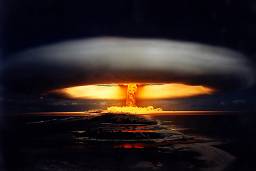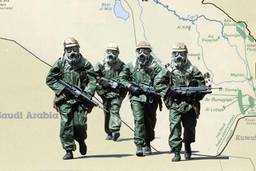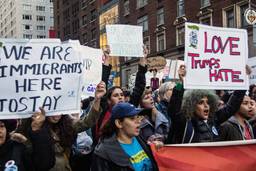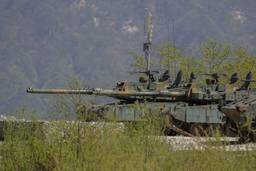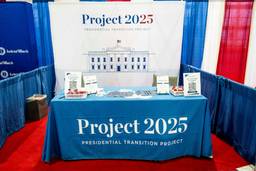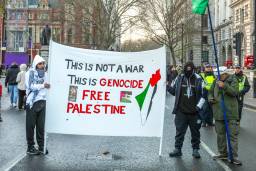As Russia Pulls Back From the Nuclear Treaty, The Fate of Humanity Hangs in the Balance
The fragility of the arms control treaty lays bare the need for nuclear abolition.
Frida Berrigan

There’s not a lot of good news.
The Bulletin of the Atomic Scientists moved its Doomsday Clock to 90 seconds to midnight to dramatize the global peril posed by nuclear weapons and climate catastrophe. Russia’s invasion of Ukraine just passed the somber and maddening one year mark. Now, in apparent retaliation for President Joe Biden’s unannounced trip to Ukraine last week, Russian President Vladimir Putin announced that his nation was done with the New START Treaty, the last remaining nuclear arms control agreement between the United States and Russia.
The New START Treaty, signed in 2011, curbed a decades-long arms race that produced tens of thousands of nuclear warheads, nearly bankrupted both nations and threatened the whole world with devastating nuclear firepower. The treaty capped at 1,550 per nation the number of nuclear warheads deployed on long-range bombers, submarines and intercontinental missile systems. Moscow and Washington further agreed to a schedule of regular inspections to confirm progress. In 2018, they mutually verified that each nation had taken enough warheads offline — by scrapping them or holding them in strategic reserve — to be in full compliance with the treaty. In 2021, they agreed to extend the terms of the treaty until 2026. But the two nations suspended inspections during the pandemic, and then the war in Ukraine ratcheted up tensions to near-apocalyptic levels.
Since Russia’s invasion a year ago, Washington and other allies have provided Ukraine with weapons, military aid, training and solidarity. The United States alone has supplied more than $27 billion in security assistance to Ukraine, including more than 1,600 Stinger anti-aircraft rocket systems, 8,500 Javelin anti-tank missile systems and over 1 million 155mm artillery rounds.hardware, training and ammunition.
The stakes were high from the beginning as nations lined up behind the invader and the invaded. Now, the future of arms control is at stake.
In a speech marking the anniversary of Russia’s invasion of Ukraine, President Vladimir Putin highlighted Western interference in the war effort for his decision to opt out of New START. “They want to inflict a strategic defeat on us and claim our nuclear facilities,” the Russian president told parliament on February 21, thus “I am forced to state that Russia is suspending its participation in the strategic offensive arms treaty.” The Russian government later said it would continue to exchange nuclear data with the United States and abide by the treaty’s limits, but observers fear Russia is one step closer to full withdrawal.
Biden called Putin’s move “a big mistake,” urging Russia to come back to the table. There’s a chance that will happen, but this flashpoint demonstrates that arms control is a poor guarantor of global stability. And it points to the need for something new.
As Dr. Ira Helfand of International Physicians for the Prevention of Nuclear War declared, “If we don’t get rid of nuclear weapons, they’re going to be used. And if they’re used, nothing else that we’re doing is going to make any difference.”
The global community has an opportunity to push hard for nuclear abolition. The International Campaign to Abolish Nuclear Weapons (ICAN) condemned Putin’s withdrawal from the treaty in strong terms. But Alicia Sanders-Zakre, ICAN’s policy and research coordinator, also stresses that “the weakening of the last remaining bilateral arms control agreement underscores the need for multilateral disarmament instruments, including the UN Treaty on the Prohibition for Nuclear Weapons,” or TPNW. So far, the TPNW has collected 92 signatory countries and 68 “states parties” still in the process of gaining ratification through their governing bodies.
The TPMW is the only global treaty to explicitly ban countries from using or threatening to use nuclear weapons. It also provides a verifiable pathway for nuclear disarmament. “Every country that joins this treaty strengthens the normative barrier against nuclear weapons,” notes Sanders-Zakre, “something that is desperately needed given the unprecedented level of nuclear risk we are facing.”
Florian Eblenkamp, an ICAN campaign officer, points to the upcoming G7 Summit as an opportunity to push the richest and most powerful countries in the world toward abolition. The meeting will be held in mid-May in Hiroshima, Japan — the first of only two cities to ever suffer the devastating impacts of a nuclear bomb attack, when the United States dropped the atomic bomb on August 6, 1945. Hiroshima is officially a “city of peace” and one role of the city government is to work for nuclear abolition. Mayor Kazumi Matsui is the President of Mayors for Peace, which represents more than 8,000 cities in 166 nations, and which issued a February 14 statement that read in part, “The only guarantee to protect humanity and the planet from the threat of nuclear weapons is their total elimination.”
ICAN, Hiroshima University and others are organizing a “Youth Summit” in Hiroshima ahead of the G7 meetings this spring, calling on young people from around the world to come and “experience the power of Hiroshima, a city that embodies the hope for a world without nuclear weapons.”
The G7 includes nuclear states the United States, France and the United Kingdom, as well as Canada, Germany, Italy and Japan. Russia left the international body in 2018, and China has yet to attain the requisite “developed nation” status despite its economic and military power. While Russia and China will not be in Hiroshima, they will be watching the proceedings closely.
Against the backdrop of the ongoing war in Ukraine, overheated rhetoric and collapsing bilateral arms control regimes, the G7 Summit is the perfect time for the richest and most powerful nations of the world to embrace the Treaty for the Prohibition of Nuclear Weapons. At 90 seconds to nuclear midnight, it is not a minute too soon.
Frida Berrigan writes for TomDispatch, Waging Nonviolence and other outlets. Her book, It Runs in the Family: On Being Raised By Radicals and Growing Into Rebellious Motherhood, was published by OR Books in 2015. She lives in New London, Conn., with her husband, three kids and six chickens.

